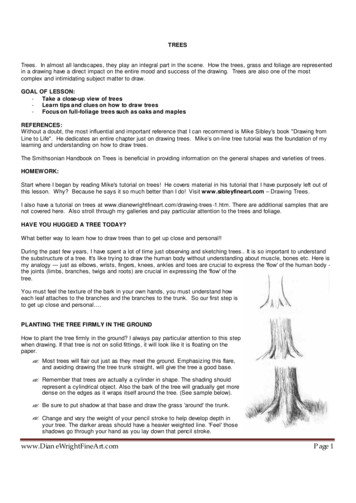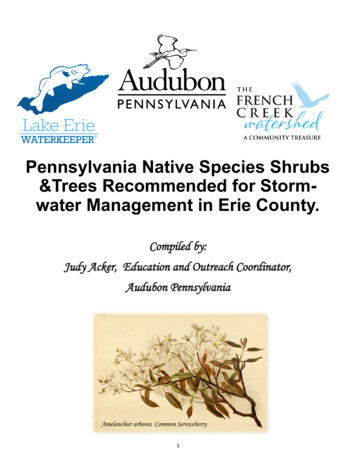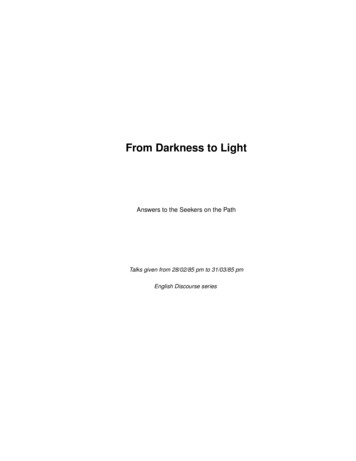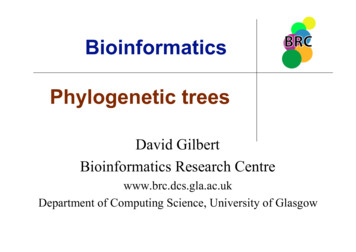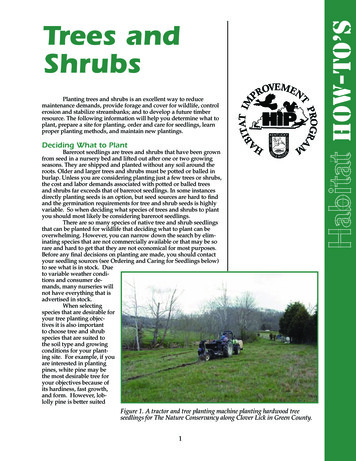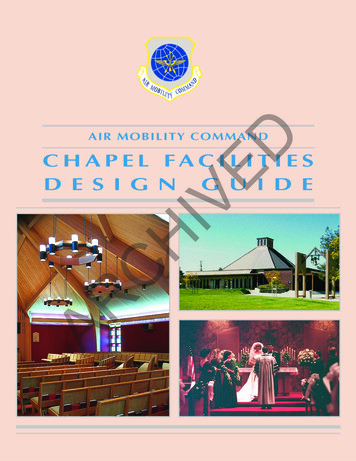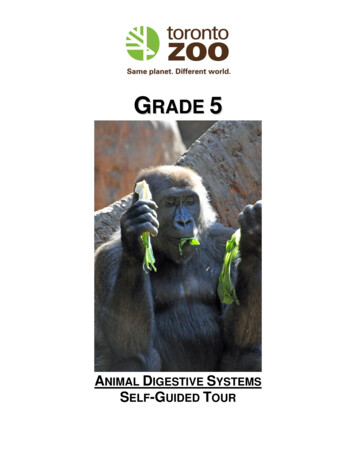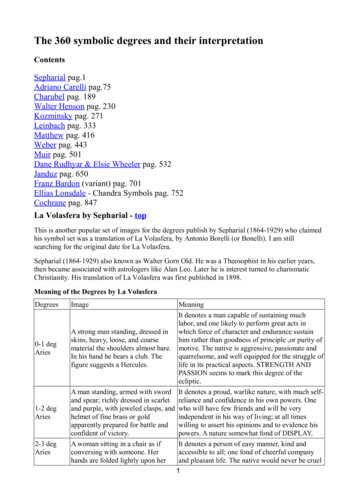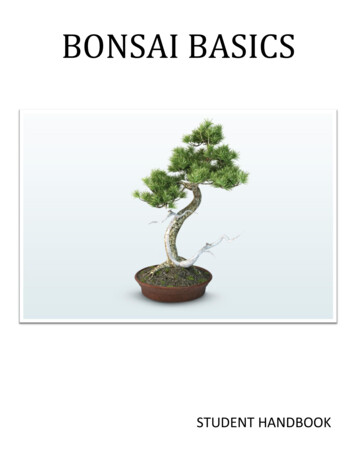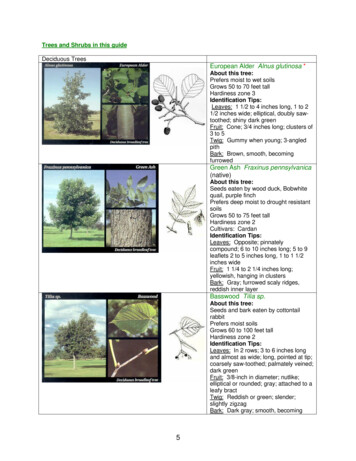
Transcription
Trees and Shrubs in this guideDeciduous TreesEuropean Alder Alnus glutinosa *About this tree:Prefers moist to wet soilsGrows 50 to 70 feet tallHardiness zone 3Identification Tips:Leaves: 1 1/2 to 4 inches long, 1 to 21/2 inches wide; elliptical, doubly sawtoothed; shiny dark greenFruit: Cone; 3/4 inches long; clusters of3 to 5Twig: Gummy when young; 3-angledpithBark: Brown, smooth, becomingfurrowedGreen Ash Fraxinus pennsylvanica(native)About this tree:Seeds eaten by wood duck, Bobwhitequail, purple finchPrefers deep moist to drought resistantsoilsGrows 50 to 75 feet tallHardiness zone 2Cultivars: CardanIdentification Tips:Leaves: Opposite; pinnatelycompound; 6 to 10 inches long; 5 to 9leaflets 2 to 5 inches long, 1 to 1 1/2inches wideFruit: 1 1/4 to 2 1/4 inches long;yellowish, hanging in clustersBark: Gray; furrowed scaly ridges,reddish inner layerBasswood Tilia sp.About this tree:Seeds and bark eaten by cottontailrabbitPrefers moist soilsGrows 60 to 100 feet tallHardiness zone 2Identification Tips:Leaves: In 2 rows; 3 to 6 inches longand almost as wide; long, pointed at tip;coarsely saw-toothed; palmately veined;dark greenFruit: 3/8-inch in diameter; nutlike;elliptical or rounded; gray; attached to aleafy bractTwig: Reddish or green; slender;slightly zigzagBark: Dark gray; smooth, becoming5
furrowed into narrow scaly ridgesEastern Cottonwood Populusdeltoides (native) *About this tree:Buds eaten by ruffed grouse and prairiechicken; bark eaten by beaverGrows over 100 feet tallHardiness zone 2Cultivars: Mighty Moe, Ohio Red,Platte, WalkerIdentification Tips:Leaves: 3 to 7 inches long; triangular;long-pointed, curved, coarse teeth;shiny green; leafstalks long, flattenedFruit: 3/8-inch elliptical capsules;splitting into 3 to 4 parts; cottony seedsBark: Yellowish-green and smooth,becoming light gray, roughTwig: Coarse, large; pointed budsCrabapple Malus sp.About this tree:Fruit is eaten by deer, pheasant, turkeyand other birdsPrefers moist to dry soilsGrows 15 to 20 feet tallHardiness zone 3Cultivars: Midwest, Roselow, MagentaIdentification Tips:Leaves: Alternate; 2 to 4 inches long;blunt jointed tip; coarsely toothed edgeFruit: 1 to 1 1/2 inches in diameter;apple; yellow-greenTwig: Stout; spreading; sometimesspines on short side branches; newgrowth is hairyBark: Lengthwise furrows and ridges;reddish-brown scalesChinese Elm Ulmus parvifolia *About this tree:Seeds eaten by purple finch, redbreasted grosbeak and cottontail rabbitPrefers moist soilsGrows 40 to 50 feet tallHardiness zone 4Identification Tips:Leaves: In 2 rows; 3/4 to 2 inches long,3/8 to 3/4 inch wide; elliptical; unequalat base; saw-toothed; shiny aboveFruit: 3/8 inch long; elliptical, flat 1 seeded; with broad pale yellow wingBark: Mottled brown; smooth; sheddingin irregular, thin flakes6
Siberian Elm Ulmus pumila *About this tree:Prefers dry to moist soilsGrows 60 feet tallHardiness zone 3Cultivars: ChinkotaIdentification Tips:Leaves: 3/4 to 2 inches long, 1/2 to 1inch wide; narrowly elliptical; bluntbased; saw-toothedFruit: 3/8 to 5/8 inch long; clustered;circular with seed in the centerBark: Gray or brown; rough, furrowedEucalyptus Eucalyptus sp. *(depending on the species)About this tree:Wood used for furniture, homesMedicinal use for oil from leavesUsed both as timber and ornamentaltreeCan grow up to 10 to 15 feet per yearand 150 feet tallHardiness zone 8Identification Tips:Leaves: Alternate; usually flattenedyellowish leafstalks; blades lanceshaped, 3 to 12 inches long, 1/2 to 2inches wide; usually dull green on bothsides; thick and leatheryFruit: Seed capsules 4-angled, about 1 inch long; or egg shaped or cylindrical,about 1/4 to 3/4 inch longFlower: Flower or flowers at leaf base;numerous spreading white or creamcolored stamensBark: Usually smooth, mottled gray,white, brown or greenish; sheds; brown,furrowed and non-shedding on RobustaEucalyptusCommon Hackberry Celtisoccidentalis (native)About this tree:Fruit eaten by robin, yellow-belliedsapsucker and cedar waxwingCan grow on moist to dry soils; tolerateshigh pHGrows 75 to 100 feet tallHardiness zone 2Cultivars: OaheIdentification Tips:Leaves: Alternate; 2 to 5 inches long;sharp-toothed; blue-greenFruit: 1/4 to 3/8 inch berry, purplebrownTwig: Gray-brown, zigzag shape7
Bark: Ridged, irregular wart-like knobsAmerican Holly Ilex opaca (native)About this tree:Fruit eaten by wild turkey, bluebird,cedar waxwingPrefers wet to moist, well drained soilsGrows 40 to 70 feet tallHardiness zone 5Identification Tips:Leaves: Evergreen; spreading in 2rows; 2 to 4 inches long, 3/4 to 1 1/20inches wide; elliptical; spiny-pointed;coarsely spiny-toothed; leatheryFruit: 1/4 to 3/8 inches in diameter;berrylike; bright redTwigs: Brown or gray; stoutBark: Light gray; thinBlack Locust Robinia pseudoacacia(native)About this tree:Seeds eaten by bobwhite quail andsquirrelPrefers moist to dry soilsGrows 40 to 80 feet tallHardiness zone 3Cultivars: SteinerIdentification Tips:Leaves: Alternate pinnately compound;6 to 12 inches long; 7 to 19 leaflets, 1 to1.75 inches long, 1/2 to 3/4 inches wide;pairedFruit: 2 to 4 inches long; narrowlyoblong flat pod; dark brownTwig: Dark brown, with stout pairedspines 1/4 to 1/2 inch long at nodesBark: Reddish brown to almost black;thick; deeply furrowed into long roughforking ridgesHoney-Locust Gleditsia triacanthos(native)About this tree:Sweetish pulp edible for humansGrows 50 to 75 feet tallHardiness zone 3Identification Tips:Leaves: Alternate; pinnately orbipinnately compound; yellow-green; 6to 8 inches long; 20 to 30 oblongleaflets 3/4 to 1 1/2 inches longFruit: Red-brown to purple; twisting; 6to 18 inches long; bean-like pod withseedsTwig: Shiny; zigzag; stout; red-brown;3-branched (1 to 3 inches); thorns 3 branched 2 to 3 inches long8
Bark: Grayish brown-black; long;irregular; vertical platesRed Maple Acer rubrum (native)About this tree:Grows well on a wide range of soiltypesFast growing; grows 50 to 70 feet tallHardiness zone 3Identification Tips:Leaves: Opposite; broadly ovate with 3shallow short-pointed lobes turning red,orange and yellow in autumnFruit: Paired single-winged seeds forma 'V'Twig: Shiny red; numerous smalllenticelsSilver Maple Acer saccharinum(native)About this tree:Seeds used by songbirds and smallmammalsPrefers moist or moderately drainedsoilsGrows 60 to 80 feet tall; 1 to 3 feet peryearHardiness zone 3Identification Tips:Leaves: Deeply separated into 5doubly-toothed lobes; opposite, simple,silvery belowFruit: Pair of wide, curved singlewinged seeds joined at base to form a'V'Bark: Light gray; on older trees platesseparated by narrow fissuresSugar Maple Acer saccharum(native)About this tree:Good wildlife valuePrefers moderately well to well drainedsoils; high shade tolerance; poordrought toleranceGrows 60 to 100 feet tallHardiness zone 3Identification Tips:Leaves: Opposite; simple; 3 to 5 lobed;pointed; slightly coarsely toothedBark: Grayish brown to black; deeplyfurrowed into hard scaly ridgesFruit: Pair of single winged seeds joinat base to form a 'V'9
Russian Mulberry Morus alba var.tatarica *About this tree:Hardy variety of white mulberryWood is hard and durableGrows to 50 feet tallWide zone of hardinessIdentification Tips:Leaves: Alternate, heart-shaped andlobed; 2 to 4 inches long and half aswideFruit: White to dark red; less than 1inch long and juicyFlower: Catkins, drooping; up to 1 inchlongTwig: Red-brown when young; gray onolder treesBur Oak Quercus macrocarpa(native)About this tree:Acorns eaten by turkey, blue jay,grouse and wood duckPrefers dry uplands to moist floodplainsGrows 50 to 80 feet tallHardiness zone 2Identification Tips:Leaves: 4 to 10 inches long, 2 to 5inches wide; obovate, lower half deeplydivided into 2 to 3 lobes on each side;dark greenFruit: Large acorns; broadly elliptical,enclosed by large deep fringed cup withconspicuous fringeBark: Light gray; thick, rough, deeplyfurrowed into scaly ridgesNorthern Red Oak Quercus rubra(native)About this tree:Acorns eaten by turkey, blue jay andruffed grousePrefers dry uplandsGrows 75 to 100 feet tallHardiness zone 3Identification Tips:Leaves: Alternate; simple; pinnately (7 11) lobed; dark green; 4 to 9 incheslongFruit: Egg-shaped, brown acorn; 1/3enclosed by shallow cup; dark marginon cup scalesBark: Dark gray-black, shallow, wideflat ridges10
Pin Oak Quercus palustris (native)About this tree:Acorn eaten by turkey, wood duck,grouse and blue jayTolerates poorly drained, wet sitesGrows 50 to 90 feet tallHardiness zone 3Identification Tips:Leaves: 3 to 5 inches long, 2 to 4inches wide; 5 to 7 deep lobes nearly tomidveinFruit: 1/2 inch long; nearly round;acorn; 1/4 to 1/3 enclosed by thinsaucer-shaped cupSawtooth Oak Quercus acutissimaAbout this tree:Excellent for wildlifePrefers moderately to well drained soils;poor shade tolerance; fair droughttoleranceGrows 35 to 70 feet tall; medium growthrateHardiness zone 5Cultivars: GobblerIdentification Tips:Leaves: Shiny; 3 to 8 inches long withbristle-like teethFruit: Small acorns; long, spreadingscales enclose two-thirds of the nutBark: Gray brown; deeply ridgedShumard Oak Quercus shumardii(native)About this tree:Acorn eaten by turkey, wood duck andblue jayPrefers moist, well drained soilsGrows 60 to 90 feet tallHardiness zone 4Identification Tips:Leaves: 3 to 7 inches long, 2 1/2 to 5inches wide; usually deeply dividednearly to midvein into 5 to 9 lobes; shinydark green above, paler below with tuftsof hair at base of veinsFruit: 5/8 to 1 inch long, egg-shaped;1/4 to 1/3 enclosed by shallow cupTwig: Hairs on the buds11
White Oak Quercus alba (native)About this tree:Acorns eaten by turkey, blue jay andruffed grousePrefers moist, well drained upland soilsGrows 80 to 100 feet tallHardiness zone 3Identification Tips:Leaves: 4 to 9 inches long; 2 to 4inches wide; elliptical; 5 to 9 lobed;bright green above, whitish or graygreen belowFruit: 3/8 to 1 1/4 inches long; eggshaped; about 1/4 enclosed by shallowwarty cupBark: Light gray; shallowly fissuredRussian-Olive Elaeagnusangustifolia *About this tree:Fruit eaten by cedar waxwings, robins,grosbeaks and pheasantsCan grow on moist to dry soilsGrows 20 to 30 feet tallHardiness zone 3Cultivars: King RedIdentification Tips:Leaves: 1 1/2 to 3 1/4 inches long;lance-shaped; dull; gray-green above,silver belowFruit: Berry-like; 3/8 to 1/2 inch indiameter; yellow to brownTwig: Silvery; often ending in shortspineBark: Gray-brown; fissured; sheddingin long stripsOsage-Orange Maclura pomifera(native)About this tree:Seeds eaten by quail and squirrelsGrows 35 to 50 feet tallExcellent fuel woodHardiness zone 4Identification Tips:Leaves: Alternate; simple; 3 to 5 incheslong; glossy bright green; leaf marginsentireFruit: Large; yellow-green; 3 to 5inches in diameterTwig: Stout; orange-brown; zigzagshape; 1/4 to 1/2 inch spinesBark: Deeply furrowed; yellow-orange brown12
Pecan Carya illinoensis (native)About this tree:Edible fruitPrefers moist, well drained, bottomlandsoilsGrows to 100 feet tallHardiness zone 4Identification Tips:Leaves: Pinnately compound; 20 to 22inches long; 11 to 17 leaflets, each 2 to7 inches long; finely saw-toothedmargin; alternateFruit: Nut; oblong; 1 to 2 inches long;pointed at tip, both endsBark: Light brown to gray; deeply,irregularly furrowedPomegranate Punica granatumAbout this tree:Cultivated for its attractive flowersTolerates heat and alkaline soilsGrows to 20 feet tallHardiness zone 7Identification Tips:Leaves: Simple; blades 1 to 3 1/2inches long; oval to elliptical tolanceolate; margin entire; surface brightgreenFruit: Berry 2 to 4 inches in diameter;thick, leathery, reddish yellow rind; juicypulpFlower: Showy; red to orange; 5 to 7petalsBark: Gray to brown on older limbsHybrid Poplar Populus sp.About this tree:Grows very fast, upright, not asspreading as cottonwoodsDisease resistantCrossbred specifically in many casesfor fast growth in windbreaksCultivars: Northwest, Norway, Imperial,RobustaIdentification Tips:Leaves: Variable but usually triangular;2 to 5 inches long and wide; usuallygreen above, light green below; toothedmargin; flattened leafstalksTwig: Short; hairlessBark: Smooth gray to off-white; deeplyfurrowed in old trees13
Lombardy Poplar Populus nigra'italica'About this tree:Prefers moist soilTree grows rapidly but is short-lived inmore humid regionsRoots are invasive and may suckerprofuselyGrows to 100 feet tallHardiness zone 4Identification Tips:Leaves: 2 to 4 inches long and wide;triangular; wavy sawtoothed; greenabove, light green below; flattenedleafstalksTwigs: Stout; hairless; orange, turninggrayBark: Gray to whitish; smooth on youngtrees and dark deep furrows on oldtreesSweetgum Liquidambar styraciflua(native)About this tree:Grows 60 to 100 feet tall; 2 to 3 feet peryearExcellent fall colorTolerates a wide range of soilsHardiness zone 6Identification Tips:Leaves: Alternate; star-shaped withpointed lobes; brilliant fall colorsFruit: Globe-shaped, tight cluster ofcapsules persist on tree over winterTwig: Moderately stout with corky wing like ridges; buds large and shinyOther: Strongly pyramidal growth formAmerican Sycamore Plantanusoccidentalis (native)About this tree:Seed eaten by purple finchPrefers moist bottomland soils; toleratespoorly drained soilsGrows 75 to 100 feet tallHardiness zone 4Identification Tips:Leaves: 4 to 8 inches long and wide;broadly ovate; 3 or 5 shallow, broad,short-pointed lobesFruit: 1 inch in diameter; usually 1brown ball hanging on long stalk;composed of narrow nutlets with hairtuftsBark: Smooth, whitish and brownmottled; peeling off in large thin flakes14
Black Walnut Juglans nigra (native)About this tree:Nuts eaten by squirrel, red and gray foxPrefers moist, well drained soilsGrows 70 to 90 feet tallHardiness zone 3Identification Tips:Leaves: Pinnately compound; 12 to 24inches long; 15 to 23 leaflets up to 5inches longFruit: Single or paired, about 2 inchesin diameter; thick green or brown huskTwig: Brown; stout; with buff coloredchambered pithBark: Dark brown; deeply furrowedridgesBlack Willow Salix nigra (native)About this tree:Prefers wet soilsGrows 60 to 100 feet tallHardiness zone 3Identification Tips:Leaves: 3 to 5 inches long, narrowlylance-shaped; shiny green on bothsidesFruit: 3/16 inch long; reddish-browncapsules; hairlessTwig: Brownish; easily detached atbaseBark: Dark brown or blackish; deeplyfurrowed into scaly, forking ridgesGolden Willow Salix alba var.vitellinaAbout this tree:Rapid growth rate with no suckeringGood winter density for a deciduoushardwoodTolerates wide range of soilsGrows to 60 feet tallHardiness zone 3Identification Tips:Leaves: Narrow lance-shaped; finelytoothed; 4 to 6 inches longFlower: Male catkins 1 to 2 inches longwith females 2 to 3 inches longTwig: Bright yellow to orangeBuds: Covered by a single nonresinous scale15
Purpleosier Willow Salix purpureaAbout this tree:Fair wildlife valueTolerates poorly drained soils; goodshade tolerance; poor drought toleranceGrows 10 to 20 feet tallHardiness zones 3 to 8Cultivars: StreamcoIdentification Tips:Leaves: In pairs, not quite opposite;smooth tongue shaped; finely-toothednear the tip only; blue-green above andpale below; 2 to 4 inches longCatkins: Small, arise in almost oppositepairs, and mature in early spring beforethe leaves come outConiferous TreesCasuarina Casuarina sp. *About this tree:Provides perching and nesting for birdsTolerates dry or wet soil, salinity, heatand windGrows 50 to 100 feet tall; grows up to 8to 10 feet per yearHardiness zone 8Identification Tips:Leaves: Scale-like; 1/8 inch longFruit: Light brown, warty ballBark: Light gray brown; smoothish onsmall trees, later becoming furrowedNorthern White Cedar (Arborvitae)Thuja occidentalis (native)About this tree:Foliage, twigs eaten by White-taileddeer, fruit eaten by various birdsPrefers neutral to alkaline soils,limestone originGrows 40 to 70 feet tallHardiness zone 2Identification Tips:Leaves: Evergreen; opposite; 1/16 to1/8 inch long; scalelike; dull yellowgreen; foliage sprays fanlikeFruit: Cone; 3/8 inch long; elliptical;upright from short curved stalkBark: Light red-brown; thin; fibrous16
Arizona Cypress Cupressusarizonica (native)About this tree:Used for erosion control, windbreaks,urban landscaping, posts, stakes andcorral polesPrefers moist gravelly soils on slopesand benchesGrows 40 to 60 feetHardiness zone 6Identification Tips:Leaves: Minute blue-green to graygreen; scale-like; sharp pointed; finelytoothed on the margins; shunlike odorwhen bruisedFruit: Dark reddish brown cones aboutone inch long that remain on the tree formany years, become gray with ageBark: Reddish brown with irregular,narrow, thin, curling scales that peel; onolder tree's, bark becomes furrowedBaldcypress Taxodium distichum(native)About this tree:Well adapted to wet sites, but can beplanted on dry sites; wood veryresistant to decay; develops 'knees'under saturated conditionsGrows 60 to 100 feet tallHardiness zone 4Identification Tips:Leaves: Needle-like; delicate; arrangedin 2 ranks in a feather-like fashion alongsmall branchlets; branchlets with fineneedles fall in the autumnFruit: Globe-shaped, woody cone, 1inch in diameter; cones disintegrate atmaturityTwig: Reddish-brown; rough, withseveral short peg-like branchesBark: Dark reddish-brown with longloose shreddy ridges17
Leland Cypress CupressocyparisleylandiiAbout this tree:Used as Christmas trees, hedgerows,windbreaks and landscapingAdapted to a wide range of soiltextures; prefers moist, well drainedsoilsGrows 60 to 70 feet tallHardiness zone 5Identification Tips:Leaves: Blue-green to gray-greenneedles, 1/8 inch long; acute;appressed with the apices of the lateralpairs often freeFruit: Cone, 1/2 to 3/4 inch in diameterwith 8 scales; each scale containsapproximately 5 seeds per scaleBark: Reddish-brown and scalyConcolor Fir Abies concolor (native)About this tree:Provides winter cover for wildlifePrefers dry to moist soilsGrows 75 to 100 feet tallHardiness zone 3Identification Tips:Leaves: Needles; slat; linear; 2-ranked;blue-green; 1 1/2 to 2 1/2 inches longFruit: Cone; erect; olive brown;cylindrical; 3 to 5 inches longTwig: Stout; yellow-green withclustered blunt, red-brown resinousbudsBark: Ash, gray-brown color; flattenedridgesDouglas-Fir Pseudotsuga menziesii(native)About this tree:Winter cover for wildlifePrefers well drained, loamy soilsGrows 80 to 200 feet tallHardiness zone 3Identification Tips:Leaves: Needles; flexible; flattened;light green-bluegreen; blunt tip; 3/4 to 11/4 inch longFruit: Cone, tan-brown; 2 to 3 incheslong; clustered pairs; 3 points;protruding bractsTwig: Slender; gray-brown; long; sharppointed budsBark: Reddish brown; deep furrows18
Rocky Mountain Juniper Juniperusscopulorum (native)About this tree:Foliage and fruit eaten by mammalsand birdsCan grow on dry to moist soilsGrows 25 to 50 feet tallHardiness zone 3Identification Tips:Leaves: Small; scale-like; opposite;smooth edges; 1 to 2 inches longFruit: Small; fleshy; berry-like; 2 to 3inches in diameter; bright blueTwig: Slender, 4-sided; becomingrounded with ageBark: Thin; reddish-brown; weatheringto grayishAustrian Pine Pinus nigraAbout this tree:Prefers dry, drought resistant soilsGrows 75 to 100 feet tallHardiness zone 3Identification Tips:Leaves: Evergreen, 3 1/2 to 6 incheslong; 2 in bundle; stiff; shiny dark green;silvery white budsFruit: Cone, 2 to 3 inches long, 1 to 11/4 inches wide; egg-shaped; shiny,yellow-brown; almost stalklessBark: Dark brown; thick; rough;furrowed into irregular scaly platesBuds: Large, silvery budsEastern White Pine Pinus strobus(native)About this tree:Prefers sandy-loam soils; avoid claywet soilsGrows 60 to 100 feet tall, 50 to 80 feetwide; growth rate is 3 to 5 feet per yearHardiness zone 3Identification Tips:Leaves: Needles in bundles of 5; 3 to 5inches long; slender; flexibleFruit: Cones; 4 to 8 inches long;cylindrical; often curvedTwig: Orange brownBark: Dark grayish brown; deeplyfurrowed on older trees; 1 to 2 inchesthick with ridges19
Eldarica Pine Pinus eldaricaAbout this tree:Prefers fine sands, silt loams to siltyclay loams, and very well drained tomoderately well drained soilsFast growth if irrigatedHardiness zone 7Identification Tips:Leaves: Needles 4 to 6 inches longborne in bundles of 2 or rarely 3; newgrowth blue-green, older growth darkergreenFruit: Cones; reddish brown to brown;borne singly or in whorls of 3 to 6;cones are ovate-conic, approximately 4inches in length; unarmedBark: Silvery gray and shiny whenyoung; becoming reddish brown;fissured and scaly on older trunksLoblolly pine Pinus taeda (native)About this tree:Seeds eaten by Bobwhite quail andmourning doveTolerates poorly drained to well drainedsoilsGrows 80 to 100 feet tallHardiness zone 7Identification Tips:Leaves: Needles; 5 to 9 inches long; 3in bundle; stout, stiff, often twistedFruit: 3 to 5 inches long; conicalBark: Blackish-gray; thick, deeplyfurrowed into scaly ridges exposingbrown inner layersPonderosa Pine Pinus ponderosa(native)About this tree:Seeds eaten by birds, mammalsCan grow on dry soilsGrows 75 to 100 feet tallHardiness zone 3Identification Tips:Leaves: Needles; stout; flexible; yellowgreen; 5 to 10 inches long; clusters of 2or 3Fruit: Cone, tan-brown; 3 to 6 incheslong; scales with pricklesTwig: Stout; orange-brown; turpentineodor when brokenBark: Black, yellow-orange (old); wide,shallow-furrowed; flaky plates20
Red Pine Pinus resinosa (native)About this tree:Seeds used by songbirds and smallmammalsPrefers well-drained, sandy soilsGrows 70 to 80 feet tallHardiness zone 2Identification Tips:Leaves: Needles; to 6 1/2 inches long;2 in a bundle; dark green, snap cleanlyFruit: Egg-shaped cones, 1 1/2 to 2 1/4inches longBark: Reddish-brown or gray; withbroad, flat, scaly plates; becoming thickScotch Pine Pinus sylvestrisAbout this tree:Prefers sandy to loam soilsGrows 50 to 75 feet tallHardiness zone 2Identification Tips:Leaves: Needles; 1 1/2 to 2 3/4 incheslong; 2 in bundle; stiff; slightly flattened;twisted; blue-greenFruit: Cone; 1 1/4 to 2 1/2 inches long;egg-shaped; pale yellow-brownBark: Reddish-brown; thin; becominggray and shredding in papery platesShortleaf Pine Pinus echinata(native)About this tree:Seeds are eaten by mourning dove andBobwhite quailPrefers dry ridges, sandy loams and siltloamsGrows 30 to 70 feet tallHardiness zone 6Identification Tips:Leaves: Needles; 4 1/2 inches long; 2or sometimes 3 in bundle; slender,flexible; dark blue-greenFruit: 1 1/2 to 2 1/2 inches long; conicalBark: Reddish-brown; large scalyplates21
Slash Pine Pinus elliottii (native)About this tree:Seeds eaten by Bobwhite quail andmourning dovePrefers poorly drained sandy soilsGrows 60 to 100 feet tallHardiness zone 7Identification Tips:Leaves: Needles; 7 to 10 inches long; 2and 3 in bundle; stout; stiff; shiny greenFruit: 2 1/2 to 6 inches long; narrowlyshaped; shiny dark brownBark: Purplish-brown; flattened, scalyplates; rough and furrowedVirginia Pine Pinus virginiana(native)About this tree:Good wildlife valuePrefers well drained soilsPoor shade toleranceGood drought toleranceGrows 30 to 40 feet tallHardiness zone 4Identification Tips:Leaves: Needles, 1 1/2 to 3 incheslong; stout; gray-green; in bundles oftwo; twistedFruit: Dark reddish-brown; ovoid;lustrous; 1 1/2 to 2 1/2 inches long, witha sharp spine at the end of each scaleBark: Shallow fissures; dark brownloose scalesEastern Redcedar Juniperusvirginiana (native)About this tree:One of the best conifers for wildlifehabitatWell adapted to most soilsGrows 25 to 60 feet tallHardiness zone 3Identification Tips:Leaves: Two types, usually on thesame tree -- scale-like and awl shapedFruit: Blue berrylike cone, 1/4 to 1/3inch in diameterTwig: 4-sided22
Colorado Blue Spruce Piceapungens (native)About this tree:Winter cover for wildlifePrefers upland dry soilsGrows 75 to 100 feet tallHardiness zone 2Identification Tips:Leaves: Needles; stiff; spirallyarranged; 4-sided; 3/4 to 1 1/2 incheslong; very prickly; sharp pointedFruit: Cone, oblong; tan-brown;cylindrical; 3 to 4 inches long; paperyscalesTwig: Stout; orange to gray-brownBark: Silvery gray-brownNorway Spruce Picea abiesAbout this tree:Foliage, twigs eaten by White-taileddeer; needles eaten by grouse; wintercover for many speciesPrefers moist soilGrows 75 to 100 feet tallHardiness zone 2Identification Tips:Leaves: Needles; 1/2 to 1 inch long;stiff; 4-angled; sharp-pointed; shiny,dark green with whitish lines; droopingfoliageFruit: Cones; 4 to 6 inches long;cylindrical; light brown; hanging downBark: Reddish-brown; scalyWhite Spruce Picea glauca (native)About this tree:Foliage, twigs eaten by White-taileddeer; needles eaten by grouse; wintercover for many speciesPrefers moist, sandy loam soilsGrows 50 to 60 feet tall; 1 to 3 feet peryearGrows 3 to 6 feet tallIdentification Tips:Leaves: Needles 1/2 to 3/4 inches long;stiff; 4-angled, sharp pointed; bluegreen, with whitish linesFruit: Cones, 1 to 2 inches longTwig: Orange-brown; slender; peglikebasesBark: Gray or brown; inner bark whitish23
* indicates the plant may be considered weedy or invasive in some parts of the US andmay not be appropriate for conservation uses in certain areas. Check with your localConservation District or state department of natural resources for more information onweediness and recommendations for use.This guide in primarily intended as an identification tool. Persons intending to use theseplants for conservation or landscape should consult additional sources of information foruse, establishment, and management of the species.PDF document prepared by the USDA-NRCS Plant Materials Program, Beltsville, MD.For more information about the PM Program visit our web site at: http://plantmaterials.nrcs.usda.govThe United States Department of Agriculture (USDA) prohibits discrimination in all its programs on the basis of race, color, nationalorigin, gender, religion, age, disability, political beliefs, sexual orientation, and marital or family status. (Not all prohibited basesapply to all programs.) Persons with disabilities who require alternative means for communication of program information (Braille,large print, audiotape, etc.) should contact USDA‘s TARGET Center at (202) 720-2600 (voice and TDD).To file a complaint of discrimination, write the USDA, Director, Office of Civil Rights, Room 326W, Whitten Building, 14th andIndependence Avenue, SW. Washington, D.C., 20250-9410 or call (202) 720-5964 (voice or TDD). USDA is an equal opportunityprovider and employer.1
Trees and Shrubs in this guide Deciduous Trees European Alder Alnus glutinosa * About this tree: Prefers moist to wet soils Grows 50 to 70 feet tall Hardiness zone 3 Identification Tips: Leaves: 1 1/2 to 4 inc
